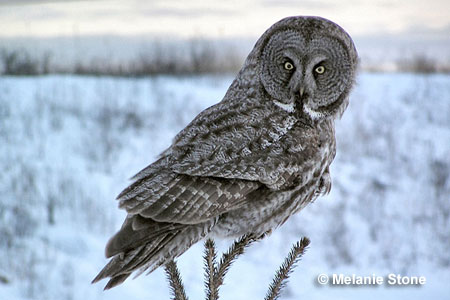The Great Gray Owl (Strix nebulosa) is a large, dark gray owl with a big, round head, and a small white “bow tie” on its throat.
This bird breeds in boreal bogs and forests in Canada and Alaska, and in montane forests in parts of the western USA. It also lives in northern Eurasia.
Watch for this uncommon owl in bogs and clearings on its breeding grounds. In the winter, look for it in similar habitats in southern Ontario and parts of the northern USA. Uncommon or rare, this spectacular owl can be tame but still hard to find!
On this page
Identification
Male
The male Great Gray Owl is a large, dark gray owl with piercing yellow eyes, and a small black and white patch on its throat. This field mark is often referred to as a “bow tie” on account of its shape, its location on the bird, and white contrast with the dark plumage.
This owl is 26 inches long, has a wingspan of 4 feet and seven inches, and weighs 1.9 pounds. It is mottled dark gray above, and has underparts with some fine barring and dark gray, black, and pale streaking.
Male Great Gray Owls have a song of nine or ten deep hoots.
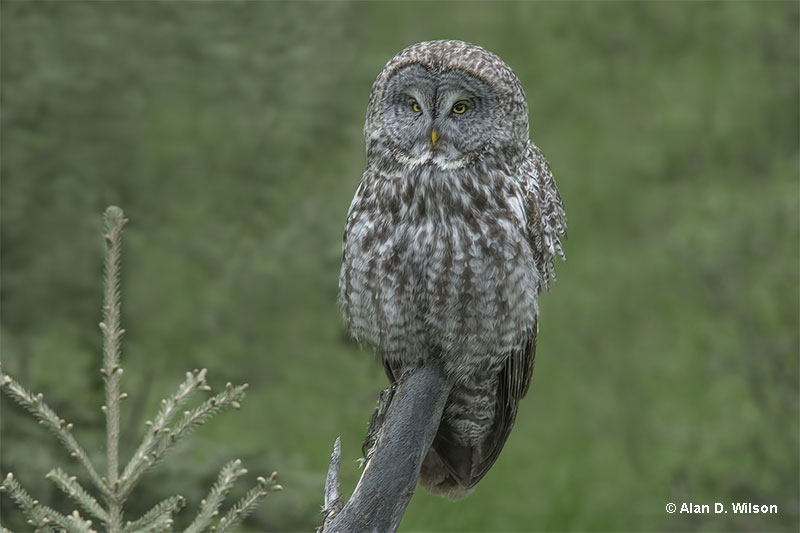
Male and female Great Gray Owls look identical, apart from their size.
Female
The female Great Gray Owl looks like the male but is bigger. On average, they are 28 inches long, have a five-foot wingspan, and weigh 2.79 pounds. Like males, females are also dark gray with mottled upperparts, have the white “bow tie,” and have dark streaks and fine barring on their underparts.
This owl also has a rounded head and fine dark barring on its round facial disk, and dark bands on its broad, medium-length tail.
They use their long, broad wings to fly with deep flaps and silent glides.
The female Great Gray Owl sings like the male but has higher-pitched hoots.
Food
The Great Gray Owl mostly feeds on small mammals. It eats voles, shrews, mice, pocket gophers, moles, and other small rodents. In general, this owl specializes on small mammals but, once in a while, it also catches small birds.
It usually feeds at night but occasionally forages during the day too, especially in the winter months. This owl hunts by waiting on a perch at the edge of a bog, meadow, or other opening in the forest.
When it sees or hears prey, the Great Gray Owl swoops in and snatches the small animal on the ground. It has fantastic hearing and may be able to detect the scurrying of voles and other rodents from 300 feet away.
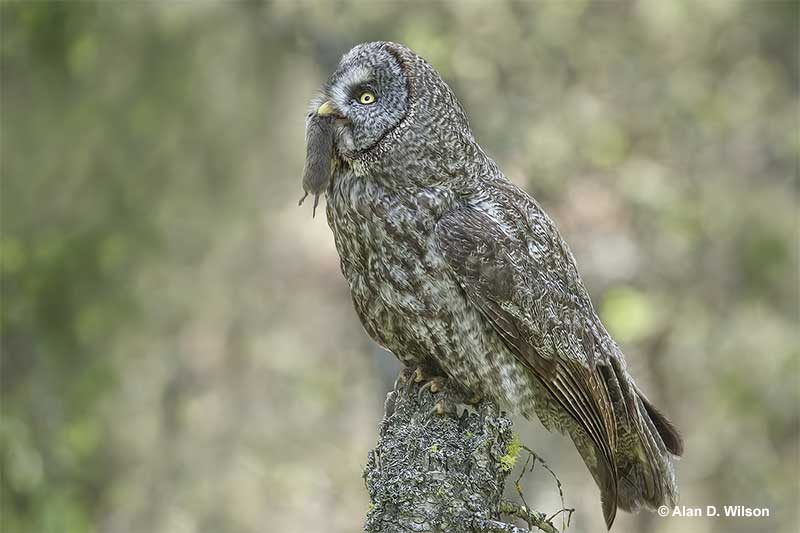
It can also hear small animals moving beneath deep snow. To catch those animals, it hovers above the snowy ground before dropping down and using its clenched feet to punch through the snow crust. After smashing through the snow, the owl grasps its prey with its talons.
Once in a while, Great Gray Owls also hunt by gliding over snowy fields or over meadows. They need these open areas for hunting, and although they do live in coniferous and montane forest, they can’t hunt in places with dense undergrowth.
Nesting and Eggs
The Great Gray Owl nests in March. To pick a nest, a pair of Great Gray Owls visits and tests out several possible nest sites.
Instead of building a nest, they usually make use of an old hawk nest, or the top of a broken-off tree trunk. They can also nest in Mistletoe bunches and on top of artificial platforms.
These big owls often use the old nests of Ospreys, Common Ravens, and Northern Goshawks, and can reuse the same nest year after year. Most nests are high above the ground although some Great Gray Owls occasionally nest on the ground.
The female lays four, dull white, 2.12 inch long eggs, and incubates them for about a month. During each day of incubation, the male owl brings three to five prey items to his mate.
He continues to bring food to the female owl and nestlings for two to three weeks more.
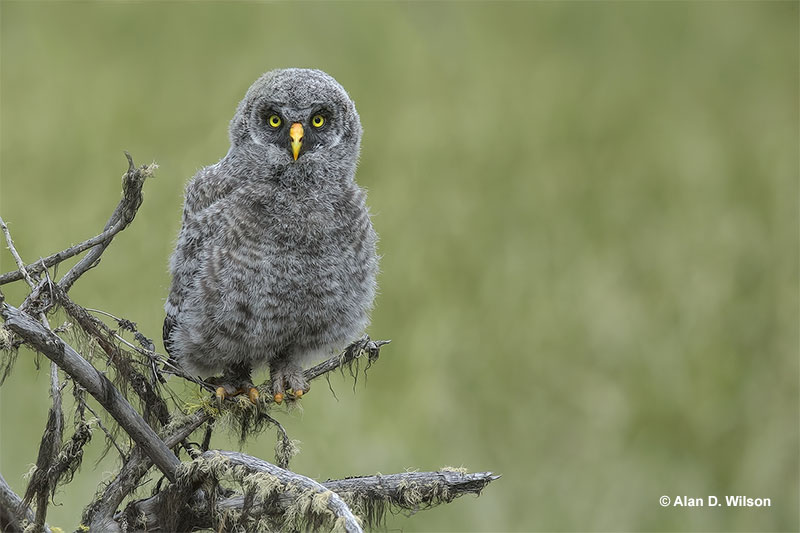
After that time, the young birds leave the nest but can’t fly for another week or two. They climb nearby vegetation and are protected by their mother for three to six weeks. At that time, the young owls are fed by their father for three months until they can hunt on their own.
Current Situation
Great Gray Owls occur in cold, boreal forests in Alaska, Canada, and a large part of northern Eurasia. They also live in montane forests in western Canada south to Idaho, Montana, and the Sierra Nevada mountains of California.
These big owls need areas of mature forest with meadows, bogs, and other openings. In winter, they can show up in similar habitats just south of their usual range.
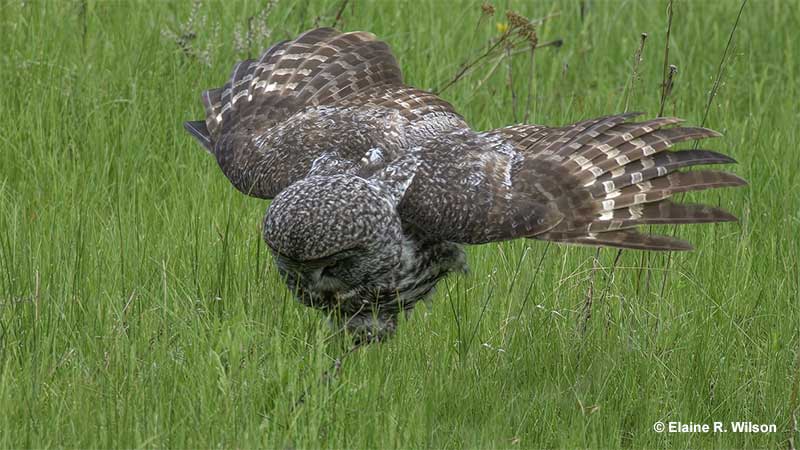
The Great Gray Owl is an uncommon or naturally rare species but is listed as Least Concern in the IUCN Red List.
This species is not endangered, but since Great Gray Owls are susceptible to changes in their habitat, Great Gray Owl nesting sites in national forests are protected from logging.
These uncommon raptors have a stable population but can be affected by logging practices that remove snags and big trees used for nesting.
In some places, they might also be affected by rodent poison, and campgrounds that use meadows required by these birds for hunting.
Facts
- To help it catch rodents under snow, the Great Gray Owl has incredible hearing augmented by its feathered facial disk. It can hear ten times better than people!
- The Great Gray Owl is the longest owl in North America but it’s not the heaviest. Feathers make up much of the bulk of this species. Both Snowy Owls and Great Horned Owls weigh more than Great Gray Owls and have stronger talons.
- This big bird needs a lot of food. To survive in the winter, Great Gray Owls have to eat seven small rodents every day.
- Once in a while, due to lack of food on their breeding grounds, large numbers of wintering Great Gray Owls can migrate to areas just south of their typical range. In the winter of 2004 and 2005, 2,000 Great Gray Owls were estimated to have migrated to Minnesota from Canada!
- In some places, this species is referred to as the “Bearded Owl.” This is in reference to the distinctive white patch on its throat.
Similar Species
The Great Gray Owl is pretty easy to recognize. Even so, since it is rarely seen, people sometimes confuse it with a few other species.
Barred Owl
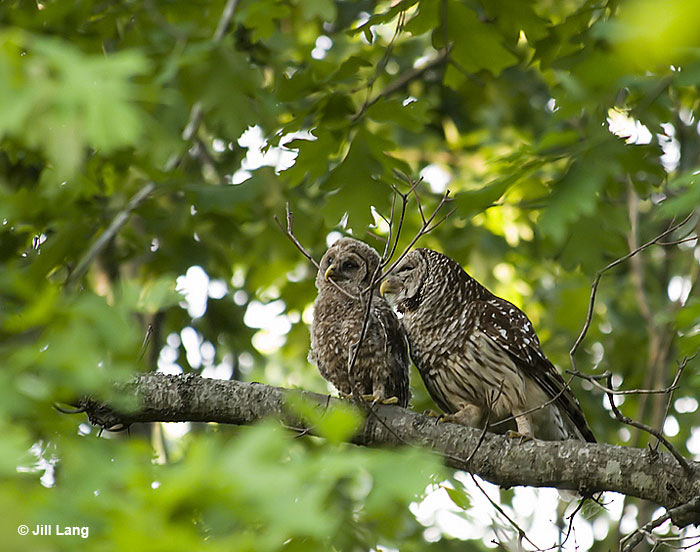
Like the Great Gray Owl, the Barred Owl also has a round head that lacks ear tufts. However, the Great Gray Owl is much darker gray and not brown. It also has small white marks on its throat and has yellow eyes.
Spotted Owl
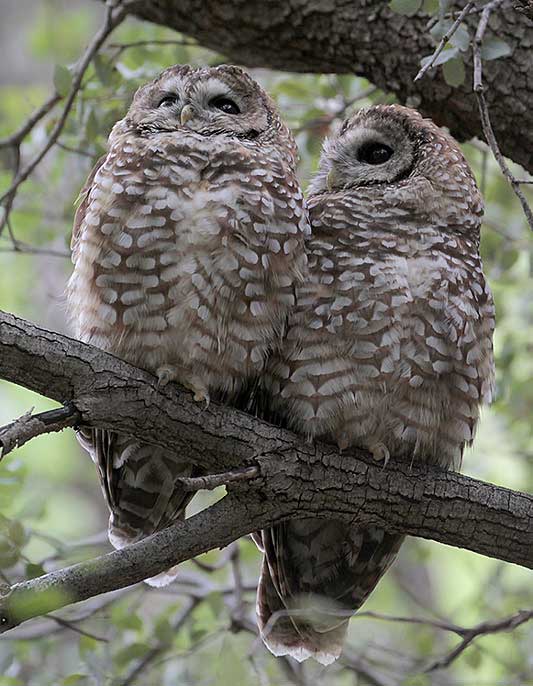
Photograph © Greg Lavaty
Spotted Owls also lack ear tufts and have a round head. However, although it is dark brown and gray, it’s not nearly as dark gray as the Great Gray Owl. Spotted Owls also have dark eyes, and white spotting in their plumage.
Great Horned Owl
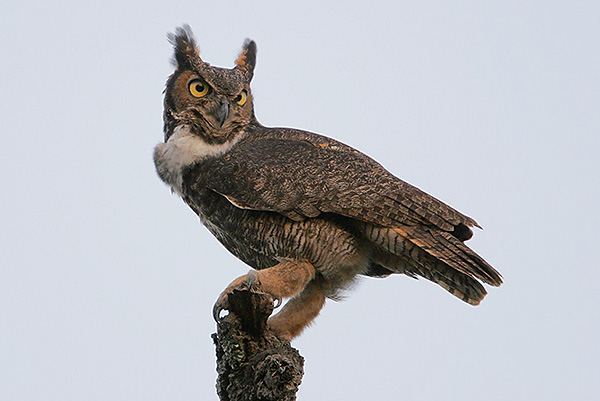
Photographs © Greg Lavaty.
The Great Horned Owl is another big owl. Some also have gray plumage a bit like a Great Gray Owl and white on their throat. However, unlike the Great Gray Owl, it has ear tufts, and fine dark barring in its underparts.
Frequently Asked Questions
Is it rare to see a Great Gray Owl?
Yes, it is rare to see a Great Gray Owl. Although these big owls can be seen on their breeding grounds and regular wintering sites, they are still uncommon and can be hard to find.
What states do Great Gray Owls live in?
Great Gray Owls live in Alaska, Idaho, Montana, Oregon, eastern Washington, and northwestern Wyoming. Some also live in California, and others winter in Minnesota, Wisconsin, and occasionally in other northern states.
Where is the best place to see Great Gray Owls?
The best place to see Great Gray Owls is in Oregon, Alaska, Canada, and Minnesota during the winter. Two of the better known sites are the Blue Mountains in northeastern Oregon, and the Sax-Zim bog in Minnesota.
What animals eat Great Gray Owls?
Few animals eat Great Gray Owls. However, in Europe, Eurasian Eagle Owls have been known to eat Great Gray Owls, and young birds can get caught by Black Bears, Great Horned Owls, Fishers, and a few other predators.
What is the lifespan of a Great Gray Owl?
The lifespan of a Great Gray Owl that reaches adulthood is 12 or more years in the wild. In captivity, one bird lived to be 27 years old.

